|
|
|
Sort Order |
|
|
|
Items / Page
|
|
|
|
|
|
|
| Srl | Item |
| 1 |
ID:
133305
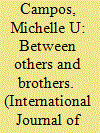

|
|
|
|
|
| Publication |
2014.
|
| Summary/Abstract |
Some fifteen years ago, the Israel Museum exhibition "To the East: Orientalism in the Arts in Israel" featured a photograph by the Israeli artist Meir Gal entitled "Nine Out of Four Hundred: The West and the Rest." At the center of the photograph was Gal, holding the nine pages that dealt with the history of Jews in the Middle East in a textbook of Jewish history used in Israel's education system. As Gal viscerally argued, "these books helped establish a consciousness that the history of the Jewish people took place in Eastern Europe and that Mizrahim have no history worthy of remembering." More damningly, he wrote that "the advent of Zionism and the establishment of the Israeli State drove a wedge between Mizrahim and their origins, and replaced their Jewish-Arab identity with a new Israeli identity based on European ideals as well as hatred of the Arab world."
|
|
|
|
|
|
|
|
|
|
|
|
|
|
|
|
| 2 |
ID:
133302


|
|
|
|
|
| Publication |
2014.
|
| Summary/Abstract |
The article is a case study of work organization at the Services d'Egypte of the Suez Canal Company from the outbreak of World War II to the company's nationalization in 1956. In this multinational and multicultural workplace, organizational hierarchies and division of labor were traditionally defined according to "national" identities, while maintaining a strict segregation between européens and indigènes, to use the company's terminology. Starting in the 1930s, the company faced new measures of economic nationalism imposed by the Egyptian government, including required quotas of Egyptian personnel. These measures progressively redefined the political boundaries of the company's action in the management of its workforce. Using unpublished archival documents from the company's personnel files, this article analyzes the processes of feminization and Egyptianization of the company's office workers during World War II and the 1950s. The process was driven by a precise organizational strategy, based on both "racial" and "gender" criteria, which aimed to redefine the company's internal hierarchies and to keep management and decision making in the hands of the "Europeans," while complying with the terms of the conventions of 1937 and 1949 that regulated the relationship between the company and the Egyptian government.
|
|
|
|
|
|
|
|
|
|
|
|
|
|
|
|
| 3 |
ID:
133304
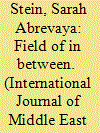

|
|
|
|
|
| Publication |
2014.
|
| Summary/Abstract |
In the spring of 1902, Miryam bint Lalu Partush appealed to military representatives in Ghardaïa, in the Mzab Valley (a valley of five fortified oasis cities in the northern Algerian Sahara, six hundred kilometers south of Algiers), for the paperwork that would allow her to undertake a six-month pilgrimage to Jerusalem with her husband, the wealthy merchant Musa (Moshe) bin Ibrahim Partush. Miryam Partush was unusual in possessing the means for such a rare, costly voyage; but notwithstanding her class, Partush's legal status was typical of most Muslims and southern Algerian Jews in Algeria. She was not a citizen, nor did she hold official papers of any kind. When Miryam Partush appealed to the military authorities in Ghardaïa, then, she was appealing for many things: for the right to leave her native valley and travel to the port of Algiers; for the papers that would allow her to cross colonial boundaries; and for the documentation that would register her liminal legal identity. Authorizing her travel, Algeria's governor-general named Partush a "non-naturalized Jew from the Mzab." Thus did Partush embark on her six-month journey with a negative legal identity: this Jewish woman was definable, in the eyes of the law, only by what she did not possess.
|
|
|
|
|
|
|
|
|
|
|
|
|
|
|
|
| 4 |
ID:
133298


|
|
|
|
|
| Publication |
2014.
|
| Summary/Abstract |
In this paper we focus on the Republican Mosque in Derinkuyu, Turkey, a Greek Orthodox church built in 1859 and transformed into a mosque in 1949 that still exhibits many obviously Christian structural features not found in most such converted churches. We utilize the concept of religioscape, defined as the distribution in spaces through time of the physical manifestations of specific religious traditions and of the populations that build them, to analyze the historical transformations of the building, and show that this incongruity marks a specific stage in the long-term competitive sharing of space by the two religiously defined communities concerned. This shared but contested space is larger than that of the building or even the town of Derinkuyu. We argue that syncretism without sharing correlates with a lack of need to show dominance symbolically, since the community that had lost the sacred building had been displaced as a group, and was no longer present to be impressed or intimidated.
|
|
|
|
|
|
|
|
|
|
|
|
|
|
|
|
| 5 |
ID:
133299
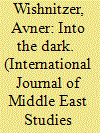

|
|
|
|
|
| Publication |
2014.
|
| Summary/Abstract |
This article analyzes different traditions of nocturnal conviviality in 18th-century Istanbul and demonstrates their importance for social, political, and cultural life. The main argument is that the palace used the night to demonstrate its power in spectacles of light and to cultivate personal relations within the elite, both of which were crucial for a patrimonial government based on face-to-face interaction. Yet, it was exactly the reliance on such interaction that marked the limits of the palace's hold of the night. With the neighborhood gaze blinded by darkness, communal policing lost much of its effectiveness, leaving nocturnal social life largely concealed from the eyes of the authorities. Nighttime therefore offered opportunities for illicit modes of socialization and, at times, for subversive political action.
|
|
|
|
|
|
|
|
|
|
|
|
|
|
|
|
| 6 |
ID:
133308
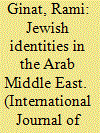

|
|
|
|
|
| Publication |
2014.
|
| Summary/Abstract |
Much work has been done in recent decades on the histories of the Jews of Arab lands across a variety of time periods, reflecting an increasing interest in the historical past of the Jews of the "Orient." While diverse, this literature may be divided into several general groups. The first comprises studies written by Western and Israeli scholars and encompasses a broad spectrum of Arabic-speaking countries. This literature has explored, among other things, issues relating to the way of life and administration of ethnically and culturally diverse Jewish communities, their approaches to Zionism and the question of their national identities, their positions regarding the Zionist-Israeli-Arab conflict in its various phases, and the phenomena of anti-Semitism, particularly in light of the increasing escalation of the conflict. It includes works by Israeli intellectuals of Mizrahi heritage, some of whom came together in the late 1990s in a sociopolitical dissident movement known as the Mizrahi Democratic Rainbow Coalition. The target audience of this movement was Mizrahi Jews: refugees and emigrants from Arab countries as well as their second- and third-generation offspring. The movement, which was not ideologically homogeneous (particularly regarding approaches to the resolution of the Israeli-Palestinian conflict), took a postcolonialist approach to the Zionist narrative and enterprise, and was critical of the entrenchment of the Ashkenazi (European-extraction) Jews among the elites of the emerging Israeli society. The movement had scant success in reaching its target population: the majority of Mizrahi/Sephardi Jews living in Israel. Nevertheless, it brought to the fore the historical socioeconomic injustices that many Jews from Arab countries had experienced since arriving in Israel, whether reluctantly or acquiescently.
|
|
|
|
|
|
|
|
|
|
|
|
|
|
|
|
| 7 |
ID:
133311
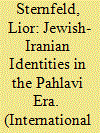

|
|
|
|
|
| Publication |
2014.
|
| Summary/Abstract |
A few years ago, while conducting archival research on Pahlavi-era Iranian newspapers, I came across a photo from the anti-shah demonstrations that took place in late 1978 and early 1979. It showed a large group of Armenians protesting against the shah. In these years many Iranians and Westerners considered the shah's policies beneficial for religious minorities in Iran. Around the same time, I found a sentence that made this discovery more intriguing. In his seminal work Iran between Two Revolutions, Ervand Abrahamian mentions that throughout the Muhammad Riza Pahlavi era, the opposition to the communist Tudeh party accused it of being controlled by "Armenians, Jews, and Caucasian émigrés." I tried to find references in the current scholarship to Jews participating in the party, which could have earned them their part in this propaganda campaign, but found very little. Having read the important works of Joel Beinin, Orit Bashkin, and Rami Ginat on Jewish revolutionaries, including communists, in the Middle East, I wondered where the Jewish radicals in Iran were. Several factors may contribute to this silence in the historiography: the writing of Iranian history from a Zionist vantage point, a lack of interest in the history of the Iranian left in the postrevolutionary historiography, and an inability to conceptualize the transregional and global nature of the Iranian Jewish community.
|
|
|
|
|
|
|
|
|
|
|
|
|
|
|
|
| 8 |
ID:
133296
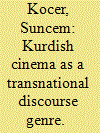

|
|
|
|
|
| Publication |
2014.
|
| Summary/Abstract |
Within the last few years, "Kurdish cinema" has emerged as a unique discursive subject in Turkey. Subsequent to and in line with efforts to unify Kurdish cultural production in diaspora, Kurdish intellectuals have endeavored to define and frame the substance of Kurdish cinema as an orienting framework for the production and reception of films by and about Kurds. In this article, my argument is threefold. First, Kurdish cinema has emerged as a national cinema in transnational space. Second, like all media texts, Kurdish films are nationalized in discourse. Third, the communicative strategies used to nationalize Kurdish cinema must be viewed both in the context of the historical forces of Turkish nationalism and against a backdrop of contemporary politics in Turkey, specifically the Turkish government's discourses and policies related to the Kurds. The empirical data for this article derive from ethnographic research in Turkey and Europe conducted between 2009 and 2012.
|
|
|
|
|
|
|
|
|
|
|
|
|
|
|
|
| 9 |
ID:
133300


|
|
|
|
|
| Publication |
2014.
|
| Summary/Abstract |
In the late 19th and early 20th century, tobacco exports from the Ottoman Empire rapidly increased. Thousands of workers began to earn their livelihoods in warehouses, sorting and baling tobacco leaves according to their qualities. Ottoman towns where tobacco warehouses were concentrated soon became the sites of frequent labor protests. This article analyzes strikes that broke out in two such towns, ?skeçe (Xanthi) and Kavala, in 1904 and 1905. It underlines the active role of the Ottoman government in the settlement of these strikes. It also shows that mobilized tobacco workers devised effective protest tactics and often secured a say in key decisions, such as when and under what conditions the warehouses operated. However, in both towns, labor activism was characterized by fragmentation as well as unity. The workers who took to the streets did not equally share the burdens and benefits of their collective actions. That inequality, the article argues, was rooted in gendered power relations, intercommunal rivalries, and other social tensions among the workers.
|
|
|
|
|
|
|
|
|
|
|
|
|
|
|
|
| 10 |
ID:
133303
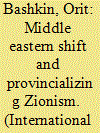

|
|
|
|
|
| Publication |
2014.
|
| Summary/Abstract |
Scholars working on Jewish communities in the Middle East are in the midst of an important historiographical moment, in which the major categories, historical narratives, and key assumptions within the field are undergoing radical changes. A cluster of books and articles written by scholars trained in history, anthropology, and area studies departments, and published in Middle East studies rather than Jewish studies book series and journals, suggests that the study of Middle Eastern Jewish communities in the American academy is undergoing a change which might be termed "the Middle Eastern turn." For such scholars, the history of Jews in Muslim lands, as modern subjects and citizens, is typified by a multiplicity of categories related to their identities-Ottoman, Sephardi, Mizrahi, Arab-Jewish, and local-patriotic-which they explore by looking at the political organizations and social and cultural institutions that enabled the integration of modern Jews into new imperial and national frameworks. This new scholarly wave is transnational, as it illustrates the importance of Jewish networks and Jewish languages in the Middle East, and likewise seeks to draw comparisons between Jews and other transregional and religious minorities, such as Armenians and Greek Orthodox Christians. It is interdisciplinary, as it attempts to incorporate the insights of sociologists, anthropologists, and literary scholars. Finally, it is postcolonial, in its critiques of national elites, national narratives, and nationalist histories. These new accounts uncover how processes which affected the entire Middle East, like Ottoman and Egyptian reform politics and the rise of nation-states, shaped modern Jewish lives.
|
|
|
|
|
|
|
|
|
|
|
|
|
|
|
|
| 11 |
ID:
133295


|
|
|
|
|
| Publication |
2014.
|
| Summary/Abstract |
This article rethinks area studies through the diasporic histories of influential graduates of the Syrian Protestant College. My focus is on Philip Hitti and his ties with fellow alumni who migrated to the Brazilian city of São Paulo. Examining his first visit to Brazil in 1925, letter exchanges through the 1940s, and a second trip in 1951, I ask how Hitti and São Paulo-based alumni sought to establish an Arab studies program in Brazil. In borrowing a template for studying the Middle East, Hitti and colleagues imbued it with a widespread sentiment that Arab and Muslim legacies of the Iberian peninsula had shaped Portugal, and thus Brazil's historical and linguistic formation. They relocated a model of area studies but refitted its content. In revealing how the institution of area studies moved across and merged with varied sociocultural settings, these diasporic histories provincialize the U.S. model for knowing the Middle East.
|
|
|
|
|
|
|
|
|
|
|
|
|
|
|
|
| 12 |
ID:
133307
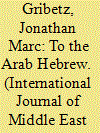

|
|
|
|
|
| Publication |
2014.
|
| Summary/Abstract |
To the Arab Hebrew [la-?ivriyah ha-?arviyah]! If you are a Hebrew, you are not an Arab. If an Arab, not a Hebrew. So, you are neither a Hebrew nor an Arab . . . C.Q.F.D." This paid announcement, published by an anonymous reader of the Jerusalem-based Hebrew newspaper ha-Tsevi on 27 November 1908, reminds us that the idea of an Arab Jew (or, in the parlance of Palestinian Hebrew in the early 20th century, an Arab Hebrew) has been at once present and contested from the early years of Zionist settlement in Palestine. Moreover, the contestation was (as it remains) often more emotional than logical (ce qu'il fallait démontrer notwithstanding). But the category of Arab Hebrew was not constructed simply to be attacked; for some, including another personal advertiser on the very same page of ha-Tsevi, Arab Hebrew was a self-proclaimed identity. "To M. M.," he or she wrote, "I saw you, I knew you, I respected you. I will leave you, I will remember you, and I will not forget you." This mysterious
|
|
|
|
|
|
|
|
|
|
|
|
|
|
|
|
| 13 |
ID:
133310
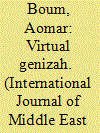

|
|
|
|
|
| Publication |
2014.
|
| Summary/Abstract |
After the establishment of the State of Israel, the Zionist narrative dominated the histories and historiographies of Middle Eastern and North African Jewries. Accordingly, Jews and Arabs were largely kept as distinct binaries divided by the intellectual walls that separated Middle East studies and Jewish studies programs. Local North African and Middle Eastern scholars also silenced or overlooked the Jewish dimension of Middle Eastern societies in the same manner that Israeli scholars ignored the historical connections between Arabs and Jews that existed both before and after 1948. The exclusive, sacred yet ebbing, nationalist paradigm has been plagued with historiographical fissures in recent decades, allowing a new wave of intellectual engagement by a young generation of Jewish and Muslim scholars who began to put the Jew and the Arab back into local and global histories formed through complex social, cultural, economic, and political networks.
|
|
|
|
|
|
|
|
|
|
|
|
|
|
|
|
|
|
|
|
|